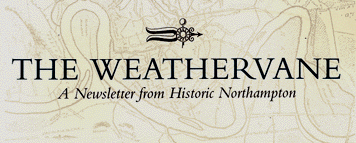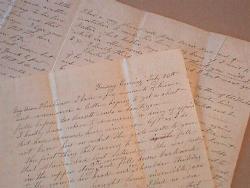

|


Weathervane Newsletter Spring 2000
 Lost Letters Chronicle Daily Life in 1840's Utopian Community Candid glimpses of Sojourner Truth, Frederick Douglass, William Lloyd Garrison and many other figures in the Abolitionist movement sparkle throughout the pages of recently discovered correspondence donated to the collections of Historic Northampton., Some 70 letters dated between 1843 and 1846 discuss the burning social and political issues of the day while also chronicling daily life in a bold experimental community established in Northampton, Massachusetts. In 1842, members of the Northampton Association of Education and Industry established a utopian community organized around a communally owned and operated silk mill. Those who were drawn to this community sought to challenge the prevailing social attitudes of their day by creating a society in which "the rights of all are equal without distinction of sex, color or condition, sect or religion." They were especially united around the issue of the abolition of slavery. Most were followers of William Lloyd Garrison. Sojourner Truth was a member of the community and visitors like Frederick Douglass were regular lecturers. Recent studies of this community have emphasized its historical importance. The discovery of these letters provides an opportunity to glimpse the daily lives and personal concerns that motivated community members. Christopher Clark, of the University of Warwick, England, author of The Communitarian Moment, noted: "this is an unusual, valuable and exciting discovery. The Stetson letters are among the largest collection anywhere that document a single family's experience of living in an American utopian community. Historians have recently been debating the roles and experiences, prticularly of women, in such communities. These letters will provide invaluable insights into such questions. They also promise to be the single most important available sources relating to the Northampton Association other than its official records at the American Antiquarian Society. Up to now we had to rely on disparate scraps of information for our understanding of life in this community. The Stetson letters promise to fill out our picture of it." Princeton University historian Nell Painter, author of Sojourner Truth, A Life, A Symbol, said: "The newly discovered Stetson letters answer a historian's prayer. What a joy to look over the Stetson family's shoulders into the everyday life of the Northampton Association! For the first time we can see Sojourner Truth as a flesh-and-blood person enmeshed in her own family and the Association's activities, not in retrospect, but, as it were, in real time."
These letters were recently discovered in the attic of a descendent of members of the utopian community (Dolly Witter Stetson and James Stetson) and were donated to Historic Northampton by the family. These letters will also provide primary historical resources to teachers and students. Middle school teacher Michael Sullivan plans to develop curricular materials around these letters that will provide firsthand insights into the daily lives of those individuals and families committed to the abolitionist and communitarian movements. In addition, the letters will enhance interpretation of the silk industry in New England. Marjorie Senechal, Smith College historian of science and Director of the Northampton Silk Project, believes "these letters provide valuable insights into the early years of the silk industry in this area. Although silk was produced here for a century, and some of the local companies became world known, very few primary documents are available, especially for the crucial years before the Civil War." |
|
|
Contents Historic Northampton. |